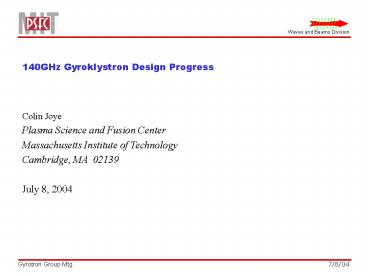140GHz Gyroklystron Design Progress
1 / 18
Title:
140GHz Gyroklystron Design Progress
Description:
Uptaper length and radius. 5 cavity radii, 5 cavity lengths, 5 cavity ohmic Q's 1 diffractive Q. 4 drift lengths, 1 drift space radius. Input power and input ... –
Number of Views:104
Avg rating:3.0/5.0
Title: 140GHz Gyroklystron Design Progress
1
140GHz Gyroklystron Design Progress Colin
Joye Plasma Science and Fusion Center Massachusett
s Institute of Technology Cambridge, MA
02139 July 8, 2004
2
GKL design goals
- Power 100 W CW output from the tube.
- 3dB bandwidth of 1 GHz.
- Current MAGY results at
- 4 perp. velocity spread
- 130 W
- 1.0 GHz of 3dB BW
- 1.3 GHz at 50 watts
3
Block Diagram
4
Why GKL design is so hard
- There are around 30 independent parameters
- Beam voltage, beam current, beam alpha
- Magnetic field, velocity spread value
- Uptaper length and radius
- 5 cavity radii, 5 cavity lengths, 5 cavity ohmic
Qs 1 diffractive Q - 4 drift lengths, 1 drift space radius
- Input power and input frequency
- Optimization stumbling blocks
- Oversaturation too much gain over a particular
frequency range - Frequency pulling which cavity is the cause?
- Each parameter contributes something to the whole
spectrum
5
GKL Design Parameters
- 5 Cavities
- V0 15 kV
- I0 0.15 A
- a 1.5
- Perp. velocity spread 4
- Input power 25mW
- B0 51.4 0.1 kG
- Now lets see some graphs!............
6
Cavity shape
7
Output cavity
Cold Cavity Code predicts a nice waveform f0
140.534 GHz Qdiff 358
8
Input power variation (1/9)
Input power variations show good
behavior. Design values give 130 W peak 1.0
GHz 3dB BW 1.3 GHz at 50W
9
Gain vs. input power (2/9)
The gain shows good behavior at all input
powers. Linear gain is 39dB Design value gain is
37dB
10
Beam current variation (3/9)
Power can be increased using I0 at the expense of
3dB BW. BW _at_ 50W goes up, though!
11
Pitch factor variation (4/9)
Pitch factor is sensitive, but can be compensated
by I0. BW _at_ 50W decreases with decreasing a.
12
v? spread variation (5/9)
This design is robust up to 6 perp vel sprd.
13
Beam voltage variation (6/9)
As predicted by linear theory, the gain generally
decreases with increasing voltage. Low voltage
is good for gain but bad for space charge.
14
Magnetic field variation (7/9)
- Even over a B0 deviation of 0.4, over 1 GHz of
BW is available at 50W. - Magnexs spec of 0.1ppm/hr Adjust the magnet
every 5 years!
15
Electric field profile (8/9)
The field profile looks fairly clean. The output
profile will change slightly after a non-linear
taper is designed.
16
Short pulse shape (9/9)
The short pulse behavior is quite good. Pulse
turn-on and turn-off delays 1ns
17
Tuning sensitivity
- The cavities need to be tuned to within 50 to 100
MHz. - Electroforming gives a tolerance of 0.2 mils, or
300 MHz. - We need a way to accurately tune the structure
a 140 GHz VNA (hint hint) and maybe a
Haimson-approved premium gold-plated hammer.
18
Conclusion
- The present GKL circuit design seems solid.
- Still to do
- Nonlinear uptaper to minimize mode conversion
- MIG design
- Mode converter (TE02 to TE01) and input coupler
- Purchase RF source
- Evaluate PBG?































